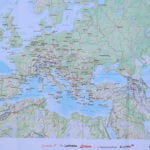1. Research and Destination Selection

Ski Trip Planning: A Journey to the Perfect Slopes
Planning a ski trip can be as exhilarating as the trip itself. With the crisp winter air and the promise of powdery slopes, selecting the right destination is crucial for a memorable ski vacation. This article will guide you through the key steps in researching and selecting your ideal ski destination, ensuring your trip is filled with breathtaking views and thrilling descents.
Understanding Your Skiing Preferences and Abilities
Before diving into the plethora of ski destinations available, it’s essential to assess your skiing skills and preferences. Are you a beginner seeking gentle slopes and comprehensive ski schools? Or are you an experienced skier looking for challenging terrain and off-piste adventures? Understanding your skill level and what you enjoy most about skiing will help narrow down the destinations that best suit your needs.
Climate and Snow Conditions: Timing Your Trip Perfectly
The timing of your ski trip significantly impacts the snow quality and overall experience. Research the typical snow conditions and climate of your shortlisted destinations during your planned travel dates. Some regions offer better conditions early in the season, while others peak in the later months. Websites like OnTheSnow.com provide current snow reports and historical data to help you make an informed decision.
Exploring Diverse Ski Destinations
From the majestic Alps in Europe to the rugged Rockies in North America, the world is home to an array of spectacular ski destinations. Each offers a unique experience, from the après-ski culture in Austria to the wide, groomed runs in Colorado. Consider factors such as the size of the ski area, the variety of runs, and the availability of other winter activities when making your choice.
Budget Considerations: Balancing Cost and Experience
Ski trips can vary widely in cost, influenced by factors like the location, accommodation type, and the duration of your stay. Set a realistic budget and compare the costs of different destinations. Look for package deals that include lift tickets, accommodation, and even flights. Remember, some of the most famous ski resorts might be more expensive, but lesser-known destinations can offer equally thrilling experiences at a fraction of the cost.
Accommodation Options: From Luxury to Budget-Friendly
The type of accommodation you choose can greatly affect your ski trip experience. Whether you prefer the luxury of a ski-in/ski-out resort or the affordability of a nearby hostel, ensure that your lodging fits your needs and budget. Consider the proximity to the ski lifts, the amenities offered, and the ease of accessing other attractions in the area.
Evaluating Ski Resort Facilities and Amenities
A ski resort’s facilities can make or break your experience. Look for resorts with a range of amenities such as quality ski rental shops, efficient lift systems, and diverse dining options. For families, resorts with childcare services and family-friendly activities can be a significant advantage.
Accessibility and Transportation
Consider the ease of reaching your chosen ski destination. Some resorts might require longer travel times or complicated transfers. Check the availability of flights, train connections, and airport transfers. A destination that’s easier to reach might allow for more time on the slopes.
Cultural Experiences and Local Attractions
While skiing might be the primary focus of your trip, exploring the local culture and attractions can enrich your experience. Research the cultural aspects of your destination, including local cuisine, historical sites, and traditional events. This can add a delightful dimension to your ski vacation.
Safety and Travel Insurance
Lastly, don’t overlook the importance of safety and travel insurance. Skiing carries inherent risks, and having comprehensive insurance that covers medical emergencies, trip cancellations, and equipment loss or damage is crucial.
By carefully researching and selecting your ski trip destination, you’re setting the stage for an unforgettable winter adventure. The perfect combination of thrilling slopes, beautiful scenery, and suitable amenities awaits – all it takes is a bit of planning to discover it.
2. Accommodation and Transportation

Finding the Perfect Home Away from Home
When planning a ski trip, choosing the right accommodation is as crucial as selecting the ski destination itself. Your accommodation sets the tone for your entire trip, offering comfort after a long day on the slopes. This segment explores various accommodation options and transportation tips to ensure a seamless ski vacation.
Accommodation Types for Every Traveler
Ski accommodations range from luxurious ski-in/ski-out resorts to budget-friendly hostels and everything in between. Consider what’s important for your stay: Do you prefer the convenience of being right on the slopes, or are you okay with a short commute for a more budget-friendly option? Here are some popular choices:
- Ski Resorts: Offering ultimate convenience and facilities such as on-site dining and ski rentals.
- Chalets: Ideal for groups seeking a homely feel with privacy.
- Apartments: A great option for families or those who prefer a self-catering option.
- Hostels: Perfect for solo travelers or those on a tight budget.
Location: Balancing Cost and Convenience
The location of your accommodation can significantly impact your ski trip experience. Staying closer to the ski lifts usually comes at a premium, but it offers unparalleled convenience. Alternatively, staying in a nearby town can be more budget-friendly and offers a chance to explore local culture but might require additional transportation to the ski area.
Booking Tips for the Best Deals
To secure the best accommodation deals:
- Book early, especially for peak seasons.
- Look for packages that might include lift tickets and meals.
- Check cancellation policies to avoid any unexpected charges.
Transportation: Getting to the Slopes
How you get to and around your ski destination is a key part of your trip planning. Whether you’re flying in and need to navigate to the ski resort, or you’re considering driving, here are some factors to keep in mind:
- Airport Transfers: Many ski resorts offer shuttle services from nearby airports. Check availability and book in advance.
- Car Rentals: Renting a car offers flexibility, especially for resorts without easy public transport links. Make sure the vehicle is equipped for winter driving conditions.
- Public Transportation: Some ski areas are well-connected by public transport, which can be a cost-effective and environmentally friendly option.
The Convenience of On-Site Transportation
Many large ski resorts offer on-site transportation, making it easy to get around without a car. This can include shuttles between different ski areas, lifts, and accommodation. Research what your chosen resort offers and plan accordingly.
Navigating with Ski Equipment
If you’re bringing your own ski equipment or planning to rent at the destination, consider how you’ll transport it. Check airline policies for ski equipment if flying, and ensure your rental car has enough space for all your gear.
Sustainable Travel Options
For the eco-conscious traveler, consider sustainable travel options. Some resorts are accessible by train, reducing your carbon footprint. Additionally, look for accommodations with eco-friendly practices.
The Role of Travel Agents
Don’t overlook the role of travel agents in planning your ski trip. They can offer valuable insights, secure deals, and arrange both accommodation and transportation, making your planning process smoother.
By carefully selecting your accommodation and planning your transportation, you can ensure a comfortable and stress-free ski vacation. Whether you’re looking for luxury or budget-friendly options, the right choices can enhance your overall skiing experience, leaving you free to enjoy the slopes to the fullest.
3. Ski Equipment and Gear
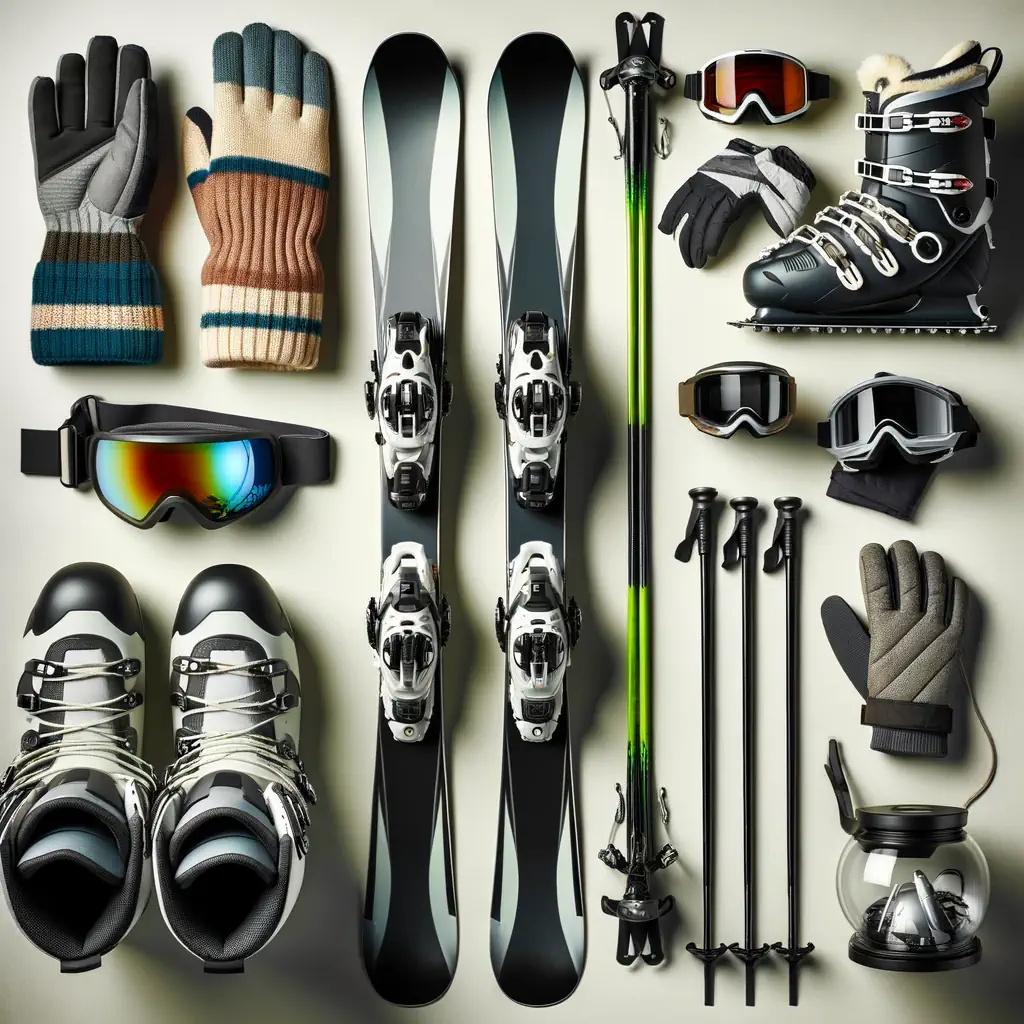
Essential Ski Equipment: Your Checklist for the Slopes
The right ski equipment and gear are fundamental to a successful and enjoyable ski trip. They not only enhance your performance on the slopes but also play a crucial role in ensuring your safety. This section covers everything you need to know about selecting and preparing your ski equipment for your next winter adventure.
Understanding Ski Equipment Basics
Your ski equipment comprises several key components, each playing a vital role in your skiing experience. Here’s a breakdown of the essentials:
- Skis: The core of your gear. Choose skis based on your skill level, style, and the terrain you’ll be tackling.
- Ski Boots: Comfort and fit are paramount. Properly fitted boots improve control and reduce the risk of injury.
- Bindings: These connect your boots to your skis and play a critical role in safety by releasing in case of a fall.
- Poles: Aid in balance and navigation, especially important for beginners and on steep terrains.
- Helmet: A non-negotiable safety item. Ensure it fits well and is specifically designed for skiing.
- Goggles: Protect your eyes from glare, wind, and snow. Look for ones with UV protection and anti-fog features.
- Gloves: Must be waterproof, insulated, and comfortable, providing both warmth and dexterity.
Renting vs. Buying Ski Gear
For beginners or those who ski infrequently, renting ski gear can be a cost-effective and convenient option. Most ski resorts offer rental services where you can get fitted with the latest equipment. However, if you ski regularly or are planning an extended trip, investing in your own gear might be more economical in the long run.
Tips for Buying Ski Gear
If you decide to purchase your ski gear, here are some tips to ensure you get the best equipment for your needs:
- Seek expert advice at specialized ski shops.
- Prioritize quality and fit over brand or aesthetics.
- Test different options if possible, especially when choosing skis and boots.
- Look for end-of-season sales to find high-quality gear at discounted prices.
Maintaining Your Ski Equipment
Proper maintenance of your ski equipment extends its life and ensures optimal performance. Regularly wax your skis, check the bindings, and store your gear in a dry, cool place. If you own your equipment, consider a professional service at least once a season.
Personal Safety Equipment: Beyond the Basics
While skis, boots, and helmets are the basics, don’t overlook other safety equipment like back protectors, especially if you’re venturing into off-piste or challenging terrains.
Clothing: Dressing for the Slopes
Apart from the hardware, your clothing is equally important. Layering is key to managing body temperature. Start with a moisture-wicking base layer, add an insulating mid-layer, and finish with a waterproof and windproof outer layer. Don’t forget thermal socks, a neck gaiter, and a warm hat.
Packing for Different Conditions
Ski conditions can vary greatly, so be prepared with gear suited for different scenarios. This includes varying lens options for your goggles to accommodate different light conditions and extra layers or a lighter jacket for temperature changes.
The Importance of Fit and Comfort
Finally, remember that comfort and fit are crucial. Ill-fitting boots or the wrong size skis can not only diminish your skiing experience but also increase the risk of injury.
By equipping yourself with the right ski gear and understanding the importance of each component, you’re setting the stage for a safer and more enjoyable ski trip. Remember, while equipment is crucial, your skills and awareness on the slopes are what ultimately make your ski experience unforgettable.
4. Ski Lessons and Guides
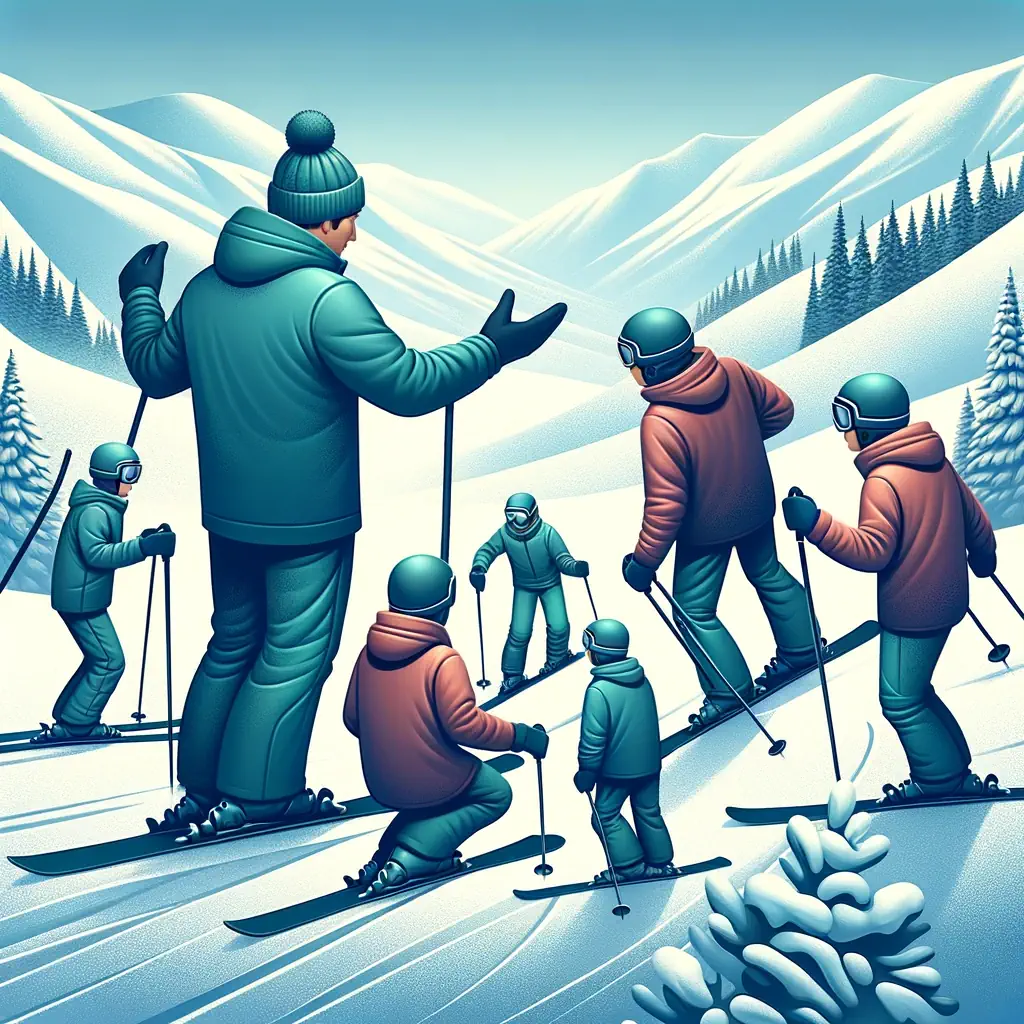
Enhancing Your Ski Experience with Professional Instruction
Whether you’re a beginner or an experienced skier looking to refine your skills, ski lessons and guides can significantly enhance your ski trip. This section explores the benefits of ski lessons, types of instruction available, and the role of ski guides in discovering the best of the slopes.
The Value of Ski Lessons
Ski lessons are not just for beginners. They are an invaluable investment for skiers of all levels. Here’s why:
- For Beginners: Learn the basics of skiing, including proper stance, turning, and stopping, in a safe and controlled environment.
- For Intermediate Skiers: Refine techniques, tackle more challenging terrain, and learn new skills like carving.
- For Advanced Skiers: Hone your skills, learn advanced techniques, and possibly explore off-piste skiing under expert guidance.
Types of Ski Lessons
- Group Lessons: Cost-effective and a great way to meet other skiers. Group sizes vary, and the instruction is more general.
- Private Lessons: Tailored to your specific needs and goals. Ideal for focused learning and rapid improvement.
- Specialty Clinics: Often focus on specific skills, such as mogul skiing, powder skiing, or race training.
Selecting a Ski School
When choosing a ski school, consider:
- Certification: Ensure instructors are certified by recognized organizations like PSIA (Professional Ski Instructors of America) or equivalent bodies in other countries.
- Reputation: Look for schools with good reviews and recommendations.
- Class Sizes: Smaller class sizes mean more personalized attention.
- Special Programs: Some schools offer programs tailored for children, women, or specific skill levels.
The Role of Ski Guides
Ski guides are invaluable for those looking to explore off-piste terrain or unfamiliar ski resorts. They offer:
- Safety: Guides are trained to navigate and assess mountain terrain safely.
- Local Knowledge: Discover the best runs, hidden spots, and enjoy a more authentic experience.
- Skill Improvement: Guides can offer tips and advice to improve your skiing in different terrains and conditions.
Booking Lessons and Guides
- Book in Advance: Especially during peak seasons or for popular instructors and guides.
- Consider Package Deals: Some resorts offer packages that include lessons, lift tickets, and even equipment rentals.
Benefits of Lessons for Children
For families, enrolling children in ski lessons can:
- Provide a Solid Foundation: Ensuring they learn proper techniques from the start.
- Offer a Fun Environment: Many ski schools have programs designed to make learning fun and engaging for kids.
- Allow Adults Free Time: While children are in lessons, adults can enjoy skiing at their own pace.
Incorporating Lessons into Your Trip
Plan your trip itinerary with lessons in mind. Consider starting your trip with lessons to improve your skills for the remainder of your stay.
Language Considerations
If you’re skiing in a non-English speaking country, check if instructors speak your language, especially for beginner lessons.
Ski lessons and guides are not just about learning; they are about enhancing your overall experience on the slopes. They provide safety, skill improvement, and the opportunity to explore the best of what a ski resort has to offer. Whether you’re a first-timer or a seasoned skier, investing in ski lessons or a guide can transform your ski trip into an unforgettable adventure.
5. Safety Precautions
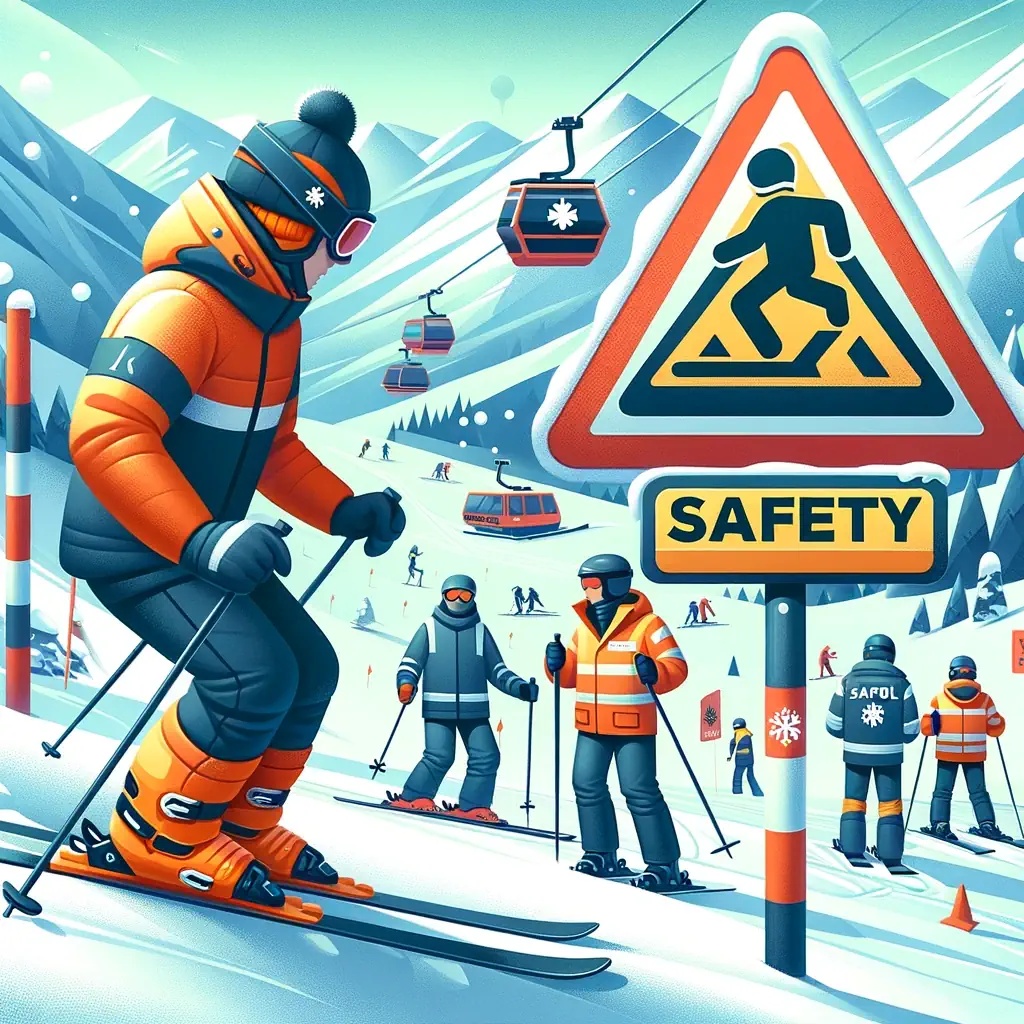
Prioritizing Safety on the Slopes
Safety is paramount when it comes to enjoying a ski trip. The thrill of skiing comes with its share of risks, but with the right precautions, you can significantly minimize them. This section focuses on essential safety measures to ensure a fun and secure skiing experience.
Understanding the Risks of Skiing
Skiing, by its nature, involves certain risks like falls, collisions, and exposure to cold temperatures. Being aware of these risks and preparing accordingly is the first step in ensuring your safety.
Wearing the Right Safety Gear
Always wear a helmet, regardless of your skill level. Helmets significantly reduce the risk of head injuries. Additionally, consider other protective gear such as wrist guards, knee pads, and back protectors, especially if you’re planning to ski in challenging terrains or trying out snowboarding.
Adhering to Ski Resort Safety Rules
Familiarize yourself with the ski resort’s safety rules and guidelines. These often include directions on right-of-way, speed limits, and designated areas for different skill levels. Respect closed trails and boundary markers; they are closed for safety reasons.
Skiing Within Your Ability Level
One of the most common causes of skiing accidents is skiing beyond one’s ability level. Stick to trails that match your skill level and avoid attempting advanced slopes before you’re ready.
Staying Alert and Being Aware of Your Surroundings
Always be aware of your surroundings and other skiers or obstacles. Keep a safe distance from others and be especially cautious in crowded areas or blind spots.
Taking Ski Lessons
If you’re a beginner or looking to improve your skills, taking lessons from a qualified instructor can greatly enhance your safety on the slopes. Even experienced skiers can benefit from advanced lessons, especially when trying new techniques or terrains.
Understanding and Preparing for Weather Conditions
Weather in the mountains can be unpredictable. Check the weather forecast and prepare for changing conditions. Dress in layers and ensure your outerwear is waterproof and windproof.
Staying Hydrated and Taking Breaks
Altitude and physical exertion can lead to dehydration and fatigue, which increases the risk of accidents. Drink plenty of water and take regular breaks.
Knowing What to Do in an Emergency
Familiarize yourself with the ski resort’s emergency procedures. Know how to contact ski patrol and what to do if you or someone else is injured. Carrying a small first aid kit can be helpful for minor injuries.
Consider Wearing a GPS or Safety Device
In remote areas or if you’re skiing off-piste, consider carrying a GPS tracker or a safety device like an avalanche transceiver.
Travel Insurance with Ski Coverage
Ensure your travel insurance covers skiing-related accidents and emergencies, especially if you’re skiing in a foreign country.
By taking these safety precautions, you can enjoy the exhilarating experience of skiing while minimizing risks. Remember, a safe ski trip is an enjoyable ski trip, and being prepared is the key to ensuring a memorable and safe skiing adventure.
6. Apres-Ski Activities
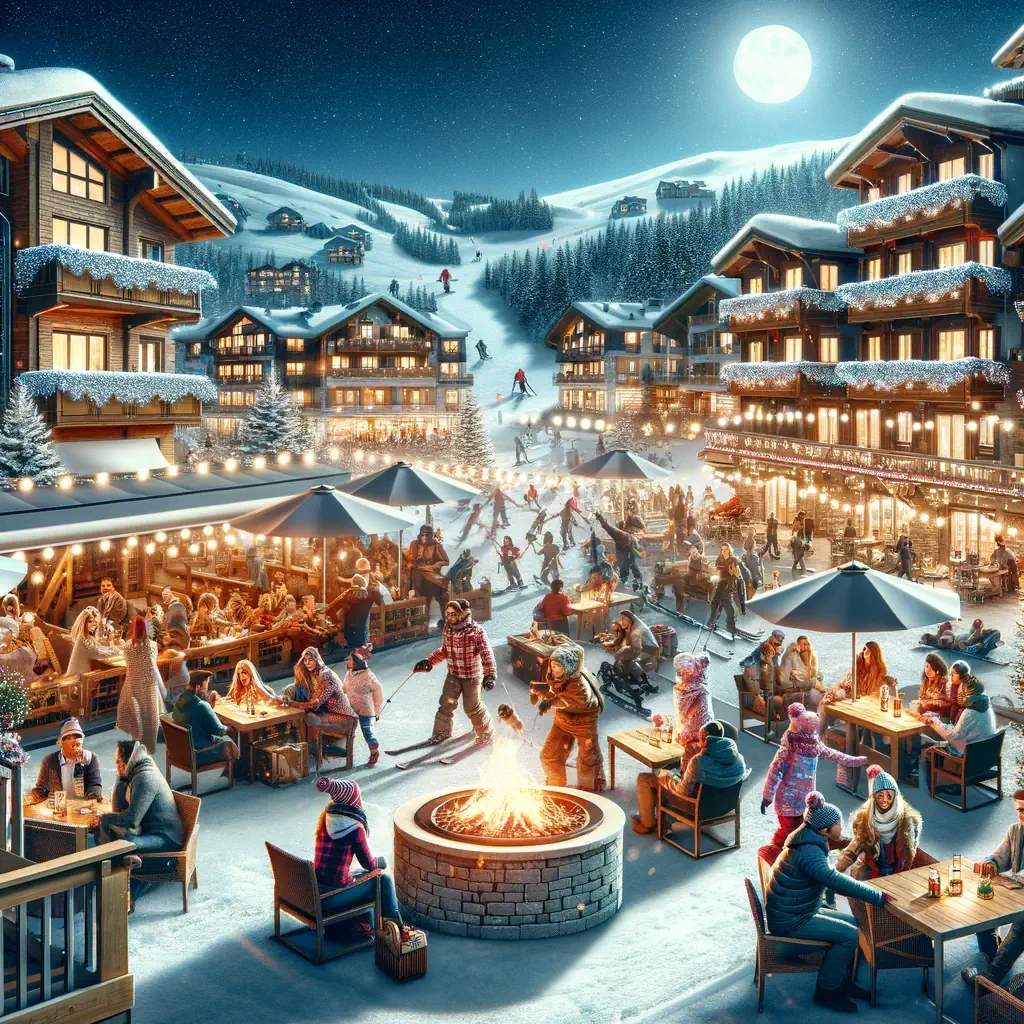
The Joy of Après-Ski: Unwinding After a Day on the Slopes
Après-ski, the time-honored tradition of relaxing and socializing after a day of skiing, is an integral part of the ski trip experience. It’s not just about the skiing; it’s also about the atmosphere, the culture, and the memories made off the slopes. This section highlights the various après-ski activities that can enhance your ski vacation.
Understanding Après-Ski Culture
Après-ski, French for “after skiing,” involves a range of activities and social events that take place at ski resorts after the day’s skiing has ended. It’s a time to unwind, indulge, and enjoy the company of fellow skiers in a fun, often festive environment.
Popular Après-Ski Activities
- Socializing at Ski Bars and Pubs: Many ski resorts boast vibrant bars and pubs where you can enjoy drinks, live music, and meet fellow skiers.
- Fine Dining and Local Cuisine: Explore the culinary delights of the region. Many ski destinations are known for their unique local dishes and high-quality restaurants.
- Outdoor Hot Tubs and Spas: Relax your muscles in a hot tub or treat yourself to a spa day. Many ski resorts offer spa services, including massages and saunas.
- Shopping and Exploring Local Towns: Take time to explore the local town, shop for souvenirs, and immerse yourself in the local culture.
- Evening Entertainment: From live music and DJ sets to themed parties and festivals, the nightlife at ski resorts can be a major draw.
Family-Friendly Après-Ski
For families, après-ski activities can include things like sledding, ice-skating, and participating in resort-organized events. Look for resorts that offer family-oriented entertainment and facilities.
Cultural Experiences
Many ski destinations are rich in culture and history. Engaging in cultural experiences such as museum visits, traditional music performances, and historical tours can add depth to your ski vacation.
Relaxation and Wellness
For those looking to relax, wellness activities like yoga classes, meditation sessions, and thermal baths can be found in many ski resorts.
The Importance of Après-Ski in Ski Resort Selection
When choosing your ski destination, consider the type and variety of après-ski activities offered. A resort with a lively après-ski scene might be perfect for groups looking for entertainment, while a more subdued, family-friendly atmosphere might be ideal for families with children.
Budgeting for Après-Ski
While après-ski activities add to the enjoyment of a ski trip, they can also add to the cost. Budget accordingly and look for resorts that offer discounts or package deals that include après-ski activities.
Safety During Après-Ski
While indulging in the après-ski scene, remember to do so responsibly, especially if you plan to ski the next day. Stay hydrated, consume alcohol in moderation, and ensure you have a safe way to return to your accommodation.
Après-ski activities are about more than just winding down after a day on the slopes; they’re about experiencing the culture, cuisine, and camaraderie that make ski trips truly memorable. Whether you prefer a quiet evening by the fireplace or a night out on the town, the après-ski experience is an essential part of your ski vacation.
7. Packing Essentials
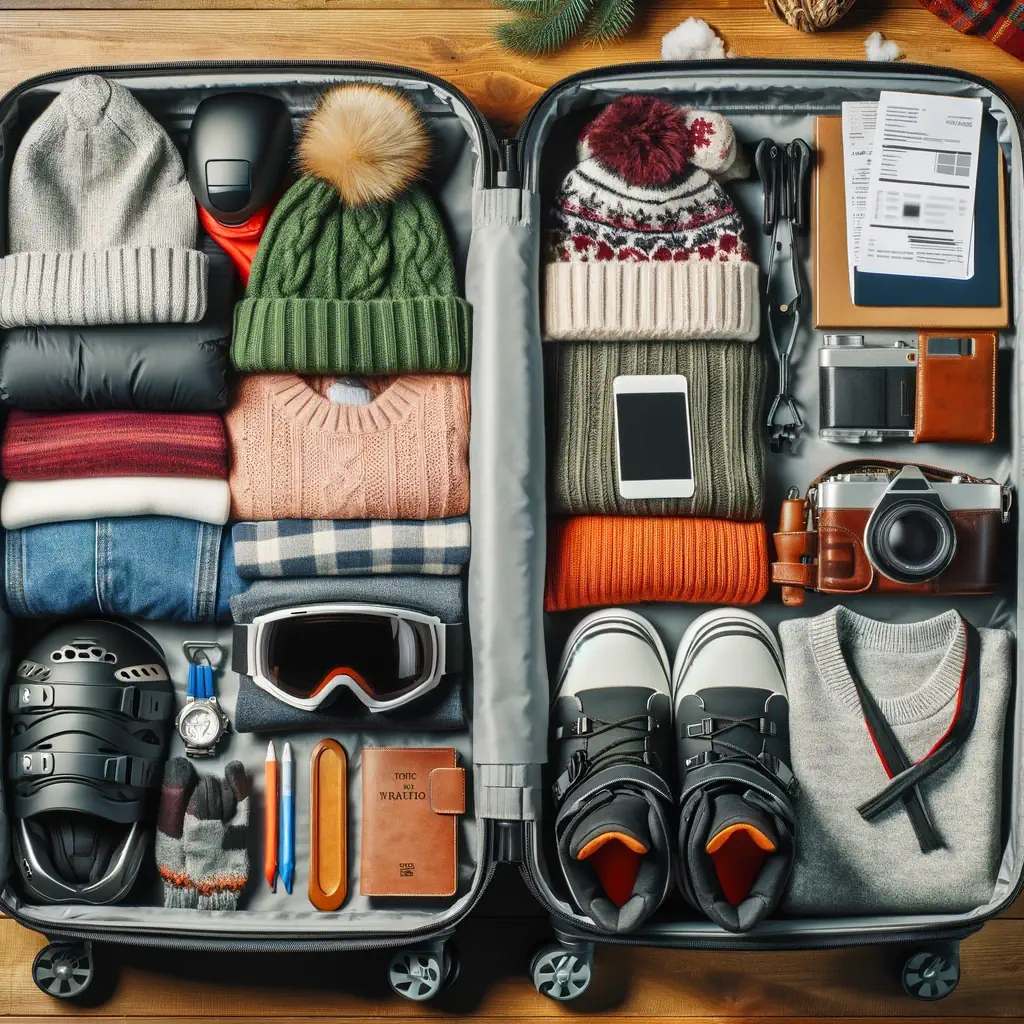
Mastering the Art of Packing for a Ski Trip
Packing for a ski trip requires a careful balance between bringing enough to stay warm and comfortable, and not overpacking. This section will guide you through the essentials to pack for your ski vacation, ensuring you’re prepared for every aspect of the trip.
Ski Wear: The Basics
- Ski Jacket and Pants: Waterproof, breathable, and insulated ski wear is a must. Look for jackets and pants with features like snow skirts and adjustable cuffs.
- Base Layers: Moisture-wicking base layers keep you dry and warm. Pack enough for your trip duration.
- Mid-Layers: Fleece or wool sweaters and vests provide additional warmth.
- Ski Socks: Several pairs of high-quality, warm, and padded ski socks are essential.
Ski Gear and Accessories
- Gloves or Mittens: Waterproof and insulated gloves are crucial. Consider bringing a spare pair.
- Beanie and Neck Gaiter: Protect your head and neck from the cold.
- Goggles and Sunglasses: UV protection for your eyes is a must on the slopes.
- Helmet: Essential for safety. Rent or bring your own.
Personal Items
- Sunscreen and Lip Balm: Protect your skin from UV rays and cold wind.
- Skincare Products: Cold weather can be harsh on your skin, so bring moisturizers and protective lotions.
- First Aid Kit: Include basics like plasters, pain relievers, and any personal medication.
Electronics and Entertainment
- Phone, Charger, and Power Bank: Stay connected and ensure your phone is always charged.
- Camera or Action Camera: Capture your ski moments.
- Entertainment: Books, tablets, or playing cards for downtime.
Travel Documents and Money
- Passport and ID: Essential for international travel.
- Travel Insurance Documents: Keep a copy of your policy.
- Credit Cards and Cash: Have a mix of payment options.
Practical Items
- Backpack or Daypack: For carrying essentials on the slopes.
- Water Bottle: Staying hydrated is important, even in cold weather.
- Snacks: Energy bars or snacks for a quick energy boost.
Packing Tips
- Use a Checklist: Avoid last-minute packing to ensure you don’t forget anything important.
- Pack Efficiently: Roll clothing to save space and use packing cubes or bags.
- Leave Some Space: For souvenirs or any additional items you might purchase.
Considerations for Special Circumstances
- Children’s Gear: If traveling with kids, remember their specific ski gear and clothing.
- Special Equipment: If you’re bringing your own skis or snowboard, ensure they are properly packed and meet airline requirements.
By carefully selecting and packing the essentials for your ski trip, you can enjoy your time on the slopes without any worries. Efficient packing not only helps in managing your luggage but also ensures that you have everything needed for a comfortable and enjoyable skiing experience. Remember, being well-prepared is key to a successful ski vacation.
8. Weather and Conditions

Navigating the Unpredictable: Weather on the Slopes
The weather in mountainous ski areas can be as exhilarating as it is unpredictable. Understanding and preparing for various weather conditions is crucial for a safe and enjoyable ski trip. This section delves into the importance of weather awareness and how to best prepare for the conditions you might encounter.
Monitoring Weather Forecasts
Before and during your trip, regularly check the weather forecasts for your ski destination. Websites like Snow-Forecast.com and local resort sites provide detailed weather reports and snow conditions. Keep an eye out for:
- Snowfall: Heavy snowfall can enhance skiing conditions but also brings challenges like reduced visibility and avalanche risk.
- Temperature: Be aware of daily temperature fluctuations which can affect snow conditions and your comfort.
- Wind: High winds can impact lift operations and your skiing experience.
- Visibility: Fog and snow can significantly reduce visibility, affecting safety on the slopes.
Preparing for Different Weather Scenarios
- Sunny Days: While ideal for skiing, don’t underestimate the sun’s strength. Wear sunscreen, UV-protective goggles, and dress in layers to manage your body temperature.
- Snowy Days: Ensure you have waterproof outerwear, anti-fog goggles, and extra layers for warmth.
- Overcast and Foggy Conditions: Use goggles with lenses suitable for low light to improve visibility.
- Varying Snow Conditions: From powder to icy patches, different snow types require different skiing techniques and caution.
Understanding Mountain Weather Variability
Mountain weather can change rapidly, so be prepared for sudden shifts. This might mean experiencing multiple weather types in a single day, so having versatile gear and clothing is essential.
Safety in Adverse Weather Conditions
In case of severe weather, like heavy snowfall or strong winds, prioritize safety. Resorts may close lifts or restrict access to certain areas. Always heed the warnings and instructions from resort management and ski patrol.
Avalanche Awareness
If you plan to ski off-piste or in backcountry areas, educate yourself about avalanche risks. Check the local avalanche forecast, carry avalanche safety equipment (like a transceiver, shovel, and probe), and consider taking an avalanche safety course.
Impact of Weather on Ski Resort Operations
Be aware that weather conditions can impact resort operations, including lift closures and restricted access to certain slopes. Have a flexible plan in case parts of the resort are inaccessible due to weather.
Staying Comfortable in All Conditions
The key to comfort is layering. Have a base layer that wicks away moisture, an insulating middle layer, and a waterproof outer layer. Adjust layers based on the weather to maintain a comfortable body temperature.
The Role of Technology
Use apps and gadgets like smartwatches that provide real-time weather updates and GPS tracking, especially useful in unfamiliar terrain or changing conditions.
Embracing the Experience
Finally, embrace the diversity of weather conditions as part of the skiing adventure. Each type of weather brings a unique aspect to skiing, from the serene beauty of snowfall to the thrill of carving down sun-lit slopes.
By being prepared and informed about the weather and conditions at your ski destination, you can ensure a more enjoyable and safer experience on the slopes. Remember, the mountain weather is a part of the adventure – respect it, prepare for it, and embrace it.
9. Budgeting and Expenses
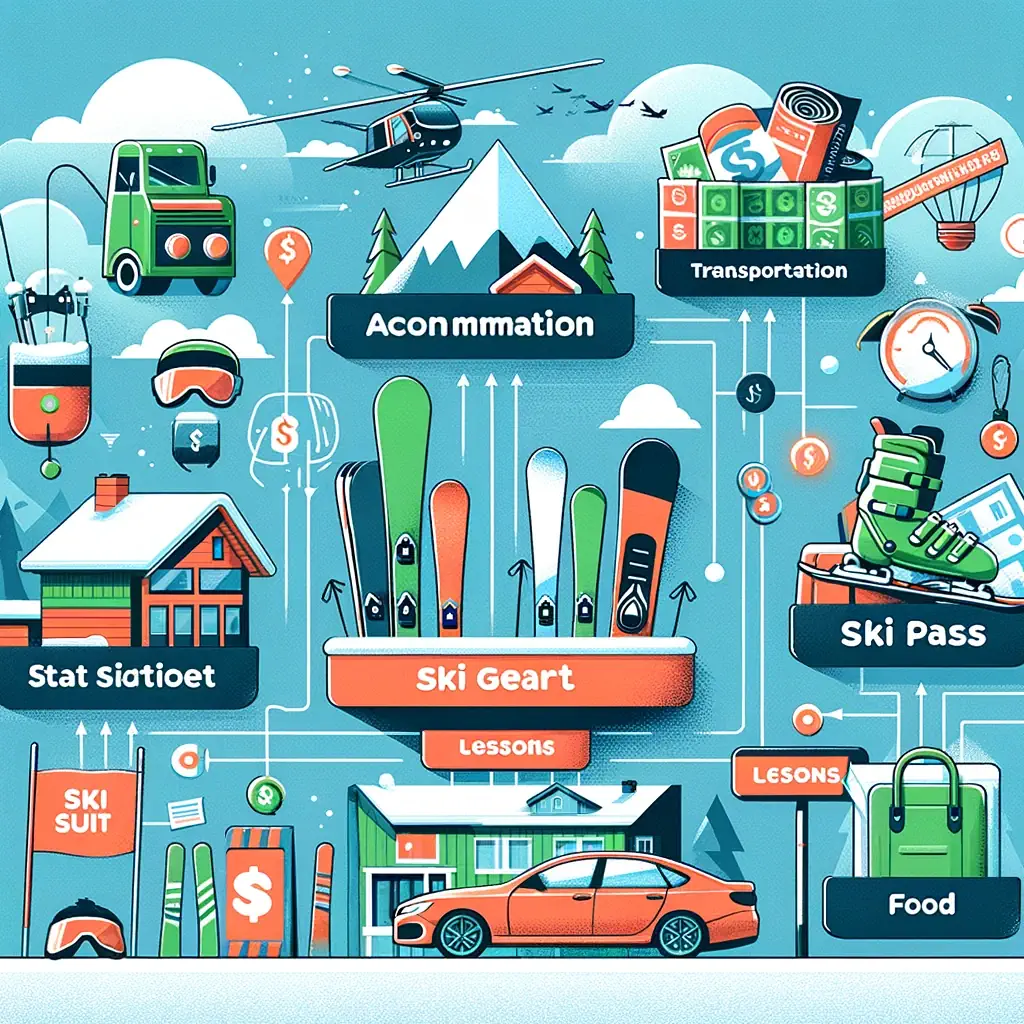
Crafting a Budget for Your Dream Ski Vacation
Ski trips can vary significantly in cost, depending on several factors like destination, accommodation, and activities. Effective budgeting is key to enjoying your ski vacation without financial strain. This section will guide you through the major expenses and tips on how to manage your budget for a ski trip.
Understanding the Main Costs
- Accommodation: Often the biggest expense. Prices vary widely based on location, type, and quality.
- Transportation: Includes travel to the ski destination and local transportation. Consider flight costs, car rentals, or public transport.
- Ski Passes: Required for access to the slopes. Prices depend on the resort and duration of the pass.
- Equipment Rental: If you don’t own ski gear, you’ll need to rent skis, boots, poles, and a helmet.
- Ski Lessons: Private lessons cost more than group lessons.
- Food and Dining: Eating out at the resort can be pricey, but there are ways to save.
- Après-Ski Activities: Entertainment and nightlife expenses can add up quickly.
Budgeting Tips
- Book in Advance: Early bookings for flights, accommodation, and ski passes often come with discounts.
- Travel Off-Peak: Consider skiing outside of peak times for lower prices and fewer crowds.
- Compare Accommodation Options: Weigh the cost vs. convenience of different lodging options.
- Consider Package Deals: Look for packages that include accommodation, ski passes, and even meals.
- Rent vs. Buy Equipment: For occasional skiers, renting might be more cost-effective.
- Self-Catering: Save on food costs by preparing your own meals if your accommodation allows.
- Set a Daily Spending Limit: Keep track of daily expenditures to avoid overspending.
Saving on Ski Passes and Lessons
- Look for Multi-Day Passes: They are usually more cost-effective than single-day passes.
- Group Lessons: More affordable than private lessons and offer a chance to meet other skiers.
Eating on a Budget
- Pack Lunches: Bring snacks and lunch to the slopes to save on food costs.
- Dine Off-Resort: Explore local eateries which might be cheaper than resort dining.
Budgeting for Unexpected Expenses
Always allocate a portion of your budget for unexpected expenses like emergency medical care or last-minute gear purchases.
Managing Money During the Trip
- Use Credit Cards Wisely: Take advantage of cards with no foreign transaction fees if traveling abroad.
- Track Your Spending: Use apps or a simple spreadsheet to monitor your expenses.
Creating a Trip Savings Plan
Start saving for your trip well in advance. Set aside a specific amount each month into a dedicated travel fund.
Value vs. Cost
While sticking to a budget is important, consider the value of your experiences. Sometimes, spending a little extra on a unique activity or better accommodation can greatly enhance your trip.
Effective budgeting and expense management are crucial for a stress-free ski vacation. By understanding the key costs and planning wisely, you can make your dream ski trip a reality without breaking the bank. Remember, careful planning and smart choices can make even the most lavish ski destinations accessible.
10. Enjoy the Experience

Savoring Every Moment of Your Ski Vacation
A ski trip is more than just an adventure; it’s an opportunity to create lasting memories, enjoy unique experiences, and embrace the joy of winter sports. This final section is a reminder to relish every moment of your ski trip, from the exhilarating descents to the tranquil moments of mountain serenity.
Embrace the Beauty of the Mountains
Take time to appreciate the breathtaking beauty of the mountain environment. Whether it’s the quiet of a snowy forest or the panoramic views from the peak, these are moments that capture the essence of a ski vacation.
Celebrate Your Skiing Achievements
Whether you’re a beginner who just mastered the basics or an experienced skier tackling a challenging run, celebrate your accomplishments. Each milestone is a step in your skiing journey.
Enjoy Quality Time with Loved Ones
Ski trips are an excellent opportunity for quality time with family and friends. Cherish these moments, whether you’re skiing together, enjoying a meal, or simply relaxing by the fire.
Explore Local Culture and Traditions
Immerse yourself in the local culture of your ski destination. Try local cuisines, participate in festivals or events, and interact with the locals. This cultural exploration can be as enriching as the skiing itself.
Relax and Unwind
Remember to relax and take care of yourself. Enjoy the après-ski activities, indulge in a spa day, or simply enjoy a hot beverage while admiring the snowy landscape.
Capture Memories
Take photos and videos to capture the moments, but also remember to put the camera away and be present. The memories you make will last a lifetime.
Be Open to New Experiences
Be open to trying new things, whether it’s a different ski discipline, a new trail, or an activity you’ve never considered before. These experiences can become the highlights of your trip.
Reflect on the Experience
Take time to reflect on your trip – the fun, the challenges, and what you’ve learned. This reflection can enhance your appreciation of the experience and provide insights for future trips.
Plan Your Next Adventure
As your ski trip comes to an end, start thinking about your next adventure. Each trip is an opportunity to explore new destinations, face new challenges, and create more memories.
The Lasting Impact of a Ski Trip
A well-planned ski trip offers more than just a break from the routine; it provides exhilaration, relaxation, and a connection with nature and people. It’s an experience that can leave you rejuvenated and enriched.
In conclusion, a ski trip is an extraordinary journey that goes beyond skiing. It’s about the joy of discovery, the thrill of adventure, and the warmth of shared experiences. So, enjoy every moment, embrace the adventure, and carry the joy of your ski trip with you long after the snow has melted.




